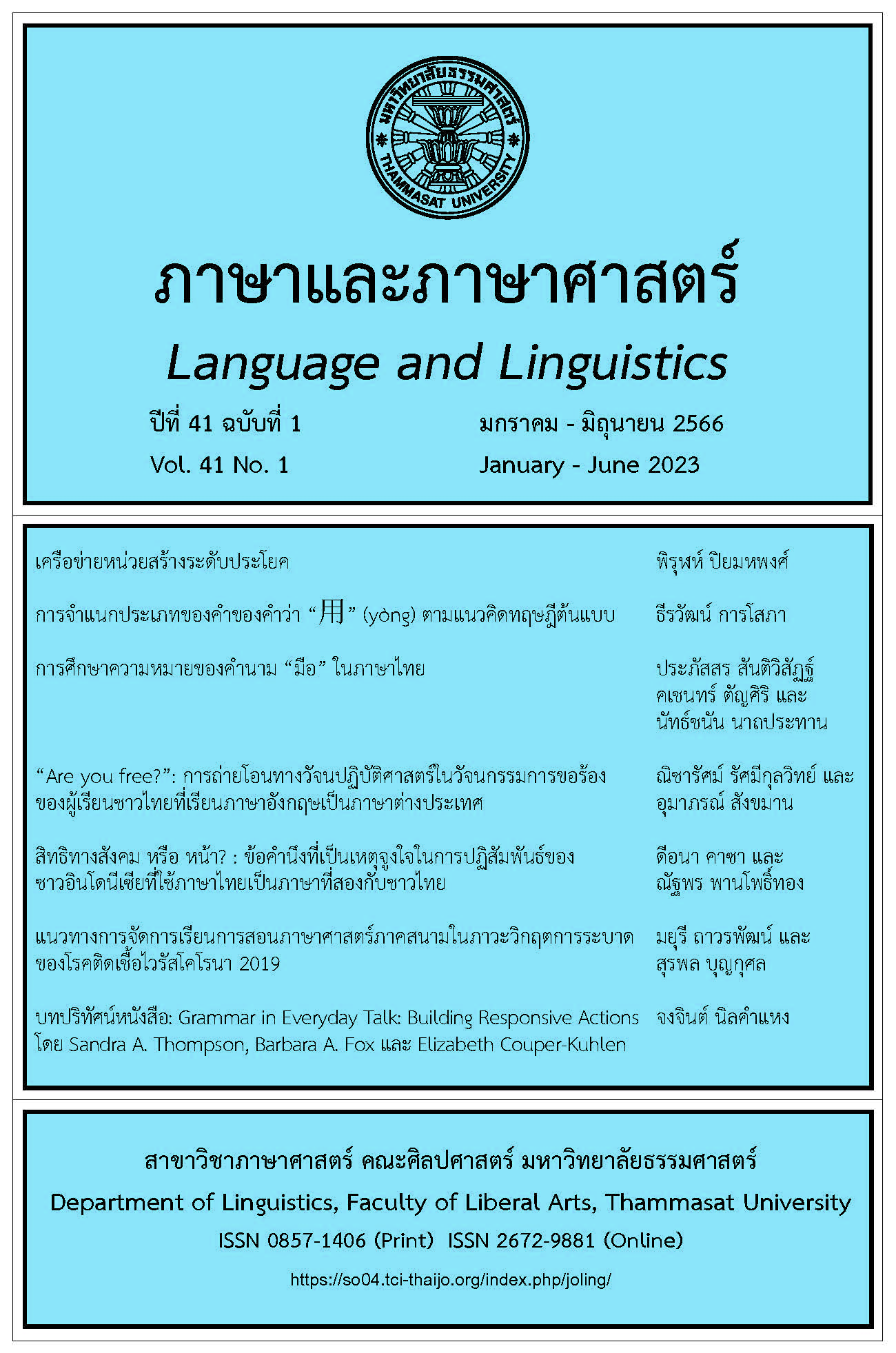Network of Sentence-Level Constructions
Main Article Content
Abstract
Polysemy, a linguistic phenomenon whereby a single form conveys multiple but related senses, is pervasive in various languages, including Thai. However, explaining cases in which polysemous lexemes occur in different syntactic contexts by adopting a lexicalist approach is not straightforward due to the indefinite proliferation of grammatical and semantic properties of the lexeme under investigation. This study thus aims to provide a unified account for earlier cases from a constructionist perspective by establishing a network of sentence-level constructions. Constructions with the verb tôk (‘to fall’) were selected to determine whether grammatical constructions within a constructicon are interconnected. Contexts with tôk were collected from Thai National Corpus under the Patronage of Her Royal Highness Princess Mahachakri Sirindhorn (TNC). Analyses reveal that the verb tôk appears in five constructions: intransitive motion constructions, caused-motion constructions, serial verb constructions, resultative constructions, and periphrastic causative constructions. These constructions are not independent but are interconnected in a network labeled as a constructional network. Based on similarities of structural patterns and schematic constructional meanings, the first two constructions are closely related and form one part of the network. Another part is made up of the other three constructions. The intransitive motion construction connects these two constitutive parts to create the entire network of sentence-level constructions with the verb tôk. In addition to illustrating the constructional network of sentence-level constructions, this study demonstrates that the horizontal relations between constructions reflect the correspondence between falling event as expressed by the verb tôk, and other events, which are the constructional meaning of each construction.
Article Details

This work is licensed under a Creative Commons Attribution-NonCommercial-NoDerivatives 4.0 International License.
บทความทุกบทความเป็นลิขสิทธิ์ของภาษาและภาษาศาสตร์
References
จุฬาลงกรณ์มหาวิทยาลัย, คณะอักษรศาสตร์, ภาควิชาภาษาศาสตร์. (ม.ป.ป.). TNC: Thai National Corpus (Third Edition) ในพระราชูปถัมภ์สมเด็จพระ เทพรัตนราชสุดาฯ สยามบรมราชกุมารี. Retrieved October 1, 2022, from https://www.arts.chula.ac.th/ling/tnc3/
พิรุฬห์ ปิยมหพงศ์. (2564). หน่วยสร้างผู้กระทำก่อการเคลื่อนที่ในภาษาไทย. วารสารภาษาและภาษาศาสตร์, 39(1), 25-53.
รัฐพล ทองแตง. (2552). หน่วยสร้างประธานรับการกระทำในภาษาไทย [วิทยานิพนธ์ปริญญามหาบัณฑิต]. จุฬาลงกรณ์มหาวิทยาลัย.
ราชบัณฑิตยสภา. (2554). พจนานุกรมฉบับราชบัณฑิตยสถาน พ.ศ. 2554. https://dictionary.orst.go.th/
วิภาส โพธิแพทย์. (2543). หน่วยสร้างการีตแบบวิเคราะห์ในภาษาไทย [วิทยานิพนธ์ปริญญามหาบัณฑิต]. จุฬาลงกรณ์มหาวิทยาลัย.
Aarts, B. (2007). Syntactic gradience: The nature of grammatical indeterminacy. Oxford University Press.
Aikhenvald, A. Y. (2018). Serial verbs. Oxford University Press.
Beavers, J., Levin, B., & Wei Tham, S. (2010). The typology of motion expressions revisited. Journal of Linguistics, 46(2), 331-377. https://doi.org/10.1017/s0022226709990272
Buchanan, M. (2002). Nexus: Small worlds and the groundbreaking theory of networks. W. W. Norton & Company.
Croft, W. (2022). Morphosyntax: Constructions of the world's languages. Cambridge University Press.
Croft, W., & Cruse, D. A. (2004). Cognitive linguistics. Cambridge University Press.
Cruse, D. A. (2006). A glossary of semantics and pragmatics. Edinburgh University Press.
Diessel, H. (2019). The grammar network: How linguistic structure is shaped by language use. Cambridge University Press.
Dominiek, S. (1998). What linguists can and can't tell you about the human mind: A reply to Croft. Cognitive Linguistics, 9(4), 361-378. https://doi.org/10.1515/cogl.1998.9.4.361
Goldberg, A. E. (1995). Constructions: A construction grammar approach to argument structure. University of Chicago Press.
Goldberg, A. E. (2006). Constructions at work: The nature of generalization in language. Oxford University Press.
Gries, S. T. (2015). Polysemy. In E. Dabrowska & D. Divjak (Eds.), Handbook of cognitive linguistics (pp. 472-489). De Gruyter Mouton.
Grinevald, C. (2011). On constructing a working typology of the expression of path. Faits de Langues, 38(2), 43-70. https://doi.org/10.1163/19589514-038-02-900000005
Haspelmath, M. (2016). The serial verb construction: Comparative concept and cross-linguistic generalizations. Language and Linguistics, 17(3), 291-319. https://doi.org/10.1177/2397002215626895
Hilpert, M. (2021). Ten lectures on diachronic construction grammar. Brill.
Hoffmann, T. (2022). Construction grammar: The structure of English. Cambridge University Press.
Kittilä, S. (2021). A typology of goal-source marking in transfer events. Studies in Language, 46(2), 352-375. https://doi.org/10.1075/sl.20020.kit
Langacker, R. W. (1987). Foundations of cognitive grammar: Theoretical prerequisites (Volume I). Stanford University Press.
Langacker, R. W. (2008). Cognitive grammar: A basic introduction. Oxford University Press.
Levin, B. (2020). Resultatives and constraints on concealed causatives. In E. A. Bar-Asher Siegal & N. Boneh (Eds.), Perspectives on causation (pp. 185-217). Springer. https://doi.org/10.1007/978-3-030-34308-8_6
Löbner, S. (2013). Understanding semantics. Routledge.
Lovestrand, J. (2021). Serial verb constructions. Annual Review of Linguistics, 7(1), 109-130. https://doi.org/10.1146/annurev-linguistics-031920-115317
Lovestrand, J., & Ross, D. (2021). Serial verb constructions and motion semantics. In A. Guillaume & H. Koch (Eds.), Associated motion (pp. 87-128). De Gruyter Mouton. https://doi.org/10.1515/9783110692099-003
Murphy, M. L. (2010). Lexical meaning. Cambridge University Press.
Rappaport Hovav, M., & Levin, B. (2010). Reflections on manner/result complementarity. In M. Rappaport Hovav (Ed.), Lexical semantics, syntax, and event structure (pp. 21-38). Oxford University Press.
Song, J. J. (2001). Linguistic typology: Morphology and syntax. Routledge.
Talmy, L. (2000). Toward a cognitive semantics: Concept structuring systems. MIT Press.
Taylor, J. R. (2017). Lexical semantics. In B. Dancygier (Ed.), The Cambridge handbook of cognitive linguistics (pp. 246-261). Cambridge University Press.
Thepkanjana, K., & Uehara, S. (2021). Verbal complexes in Thai. In T. Kageyama (Ed.), Verb-verb complexes in Asian languages (pp. 499-520). Oxford University Press. https://doi.org/10.1093/oso/9780198759508.003.0019
Van de Velde, F. (2014). Degeneracy: The maintenance of constructional networks. In R. Boogaart, T. Colleman, & G. Rutten (Eds.), Extending the scope of construction grammar (pp. 141-180). De Gruyter Mouton. https://doi.org/10.1515/9783110366273.141
Vicente, A., & Falkum, I. L. (2017) Polysemy. In M. Aronoff (Ed.), Oxford research encyclopedia of linguistics. Oxford University Press. https://doi.org/10.1093/acrefore/9780199384655.013.325
Ziegeler, D. (2004). Grammaticalisation through constructions: The story of causativehavein English. Annual Review of Cognitive Linguistics, 2(1), 159-195. https://doi.org/10.1075/arcl.2.06zie


